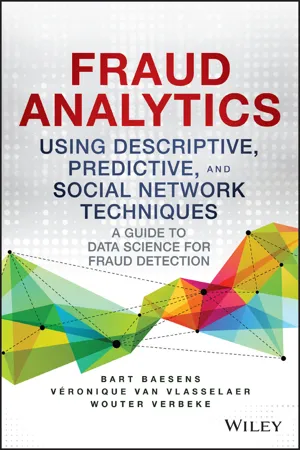
Fraud Analytics Using Descriptive, Predictive, and Social Network Techniques
A Guide to Data Science for Fraud Detection
- English
- ePUB (mobile friendly)
- Available on iOS & Android
Fraud Analytics Using Descriptive, Predictive, and Social Network Techniques
A Guide to Data Science for Fraud Detection
About this book
Detect fraud earlier to mitigate loss and prevent cascading damage
Fraud Analytics Using Descriptive, Predictive, and Social Network Techniques is an authoritative guidebook for setting up a comprehensive fraud detection analytics solution. Early detection is a key factor in mitigating fraud damage, but it involves more specialized techniques than detecting fraud at the more advanced stages. This invaluable guide details both the theory and technical aspects of these techniques, and provides expert insight into streamlining implementation. Coverage includes data gathering, preprocessing, model building, and post-implementation, with comprehensive guidance on various learning techniques and the data types utilized by each. These techniques are effective for fraud detection across industry boundaries, including applications in insurance fraud, credit card fraud, anti-money laundering, healthcare fraud, telecommunications fraud, click fraud, tax evasion, and more, giving you a highly practical framework for fraud prevention.
It is estimated that a typical organization loses about 5% of its revenue to fraud every year. More effective fraud detection is possible, and this book describes the various analytical techniques your organization must implement to put a stop to the revenue leak.
- Examine fraud patterns in historical data
- Utilize labeled, unlabeled, and networked data
- Detect fraud before the damage cascades
- Reduce losses, increase recovery, and tighten security
The longer fraud is allowed to go on, the more harm it causes. It expands exponentially, sending ripples of damage throughout the organization, and becomes more and more complex to track, stop, and reverse. Fraud prevention relies on early and effective fraud detection, enabled by the techniques discussed here. Fraud Analytics Using Descriptive, Predictive, and Social Network Techniques helps you stop fraud in its tracks, and eliminate the opportunities for future occurrence.
Frequently asked questions
- Essential is ideal for learners and professionals who enjoy exploring a wide range of subjects. Access the Essential Library with 800,000+ trusted titles and best-sellers across business, personal growth, and the humanities. Includes unlimited reading time and Standard Read Aloud voice.
- Complete: Perfect for advanced learners and researchers needing full, unrestricted access. Unlock 1.4M+ books across hundreds of subjects, including academic and specialized titles. The Complete Plan also includes advanced features like Premium Read Aloud and Research Assistant.
Please note we cannot support devices running on iOS 13 and Android 7 or earlier. Learn more about using the app.
Information
Chapter 1
Fraud: Detection, Prevention, and Analytics!
Introduction
Fraud!
Table of contents
- Cover
- Title Page
- Copyright
- Table of Contents
- Dedication
- List of Figures
- Foreword
- Preface
- Acknowledgments
- Chapter 1: Fraud: Detection, Prevention, and Analytics!
- Chapter 2: Data Collection, Sampling, and Preprocessing
- Chapter 3: Descriptive Analytics for Fraud Detection
- Chapter 4: Predictive Analytics for Fraud Detection
- Chapter 5: Social Network Analysis for Fraud Detection
- Chapter 6: Fraud Analytics: Post-Processing
- Chapter 7: Fraud Analytics: A Broader Perspective
- About the Authors
- Index
- End User License Agreement